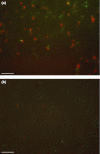Biofilm formation of Klebsiella pneumoniae on urethral catheters requires either type 1 or type 3 fimbriae
- PMID: 22448614
- PMCID: PMC3410544
- DOI: 10.1111/j.1574-695X.2012.00965.x
Biofilm formation of Klebsiella pneumoniae on urethral catheters requires either type 1 or type 3 fimbriae
Abstract
Urinary catheters are standard medical devices utilized in both hospital and nursing home settings, but are associated with a high frequency of catheter-associated urinary tract infections (CAUTI). In particular, biofilm formation on the catheter surface by uropathogens such as Klebsiella pneumoniae causes severe problems. Here we demonstrate that type 1 and type 3 fimbriae expressed by K. pneumoniae enhance biofilm formation on urinary catheters in a catheterized bladder model that mirrors the physico-chemical conditions present in catheterized patients. Furthermore, we show that both fimbrial types are able to functionally compensate for each other during biofilm formation on urinary catheters. In situ monitoring of fimbrial expression revealed that neither of the two fimbrial types is expressed when cells are grown planktonically. Interestingly, during biofilm formation on catheters, both fimbrial types are expressed, suggesting that they are both important in promoting biofilm formation on catheters. Additionally, transformed into and expressed by a nonfimbriated Escherichia coli strain, both fimbrial types significantly increased biofilm formation on catheters compared with the wild-type E. coli strain. The widespread occurrence of the two fimbrial types in different species of pathogenic bacteria stresses the need for further assessment of their role during urinary tract infections.
© 2012 Federation of European Microbiological Societies. Published by Blackwell Publishing Ltd. All rights reserved.
Figures




Similar articles
-
Type 1 fimbriae contribute to catheter-associated urinary tract infections caused by Escherichia coli.J Bacteriol. 2014 Mar;196(5):931-9. doi: 10.1128/JB.00985-13. Epub 2013 Dec 13. J Bacteriol. 2014. PMID: 24336940 Free PMC article.
-
Role of type 1 and type 3 fimbriae in Klebsiella pneumoniae biofilm formation.BMC Microbiol. 2010 Jun 23;10:179. doi: 10.1186/1471-2180-10-179. BMC Microbiol. 2010. PMID: 20573190 Free PMC article.
-
Role of Klebsiella pneumoniae type 1 and type 3 fimbriae in colonizing silicone tubes implanted into the bladders of mice as a model of catheter-associated urinary tract infections.Infect Immun. 2013 Aug;81(8):3009-17. doi: 10.1128/IAI.00348-13. Epub 2013 Jun 10. Infect Immun. 2013. PMID: 23753626 Free PMC article.
-
Klebsiella pneumoniae and type 3 fimbriae: nosocomial infection, regulation and biofilm formation.Future Microbiol. 2012 Aug;7(8):991-1002. doi: 10.2217/fmb.12.74. Future Microbiol. 2012. PMID: 22913357 Review.
-
Bacterial biofilm formation on indwelling urethral catheters.Lett Appl Microbiol. 2019 Apr;68(4):277-293. doi: 10.1111/lam.13144. Lett Appl Microbiol. 2019. PMID: 30811615 Review.
Cited by
-
Promising Therapeutic Strategies Against Microbial Biofilm Challenges.Front Cell Infect Microbiol. 2020 Jul 28;10:359. doi: 10.3389/fcimb.2020.00359. eCollection 2020. Front Cell Infect Microbiol. 2020. PMID: 32850471 Free PMC article. Review.
-
Correlation between Antibiotics-Resistance, Virulence Genes and Genotypes among Klebsiella pneumoniae Clinical Strains Isolated in Guangzhou, China.Curr Microbiol. 2024 Jul 30;81(9):289. doi: 10.1007/s00284-024-03818-2. Curr Microbiol. 2024. PMID: 39078504
-
Positive autoregulation of mrkHI by the cyclic di-GMP-dependent MrkH protein in the biofilm regulatory circuit of Klebsiella pneumoniae.J Bacteriol. 2015 May;197(9):1659-67. doi: 10.1128/JB.02615-14. Epub 2015 Mar 2. J Bacteriol. 2015. PMID: 25733612 Free PMC article.
-
Role of enteroaggregative Escherichia coli virulence factors in uropathogenesis.Infect Immun. 2013 Apr;81(4):1164-71. doi: 10.1128/IAI.01376-12. Epub 2013 Jan 28. Infect Immun. 2013. PMID: 23357383 Free PMC article.
-
Adhesion of Escherichia coli under flow conditions reveals potential novel effects of FimH mutations.Eur J Clin Microbiol Infect Dis. 2017 Mar;36(3):467-478. doi: 10.1007/s10096-016-2820-8. Epub 2016 Nov 5. Eur J Clin Microbiol Infect Dis. 2017. PMID: 27816993 Free PMC article.
References
-
- Adegbola RA, Old DC. Fimbrial haemagglutinins in Enterobacter species. J Gen Microbiol. 1983;129:2175–2180. - PubMed
-
- Adegbola RA, Old DC. Fimbrial and non-fimbrial haemagglutinins in Enterobacter aerogenes. J Med Microbiol. 1985;19:35–43. - PubMed
-
- An D, Parsek MR. The promise and peril of transcriptional profiling in biofilm communities. Curr Opin Microbiol. 2007;10:292–296. - PubMed
Publication types
MeSH terms
Substances
Grants and funding
LinkOut - more resources
Full Text Sources
Medical
Molecular Biology Databases
